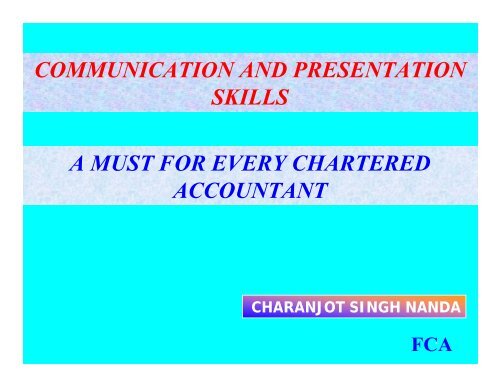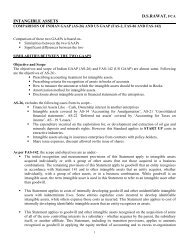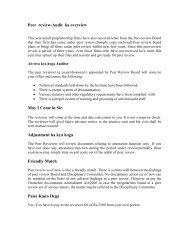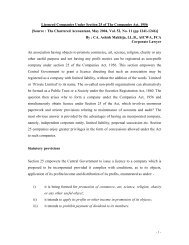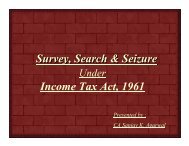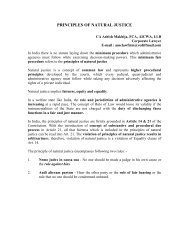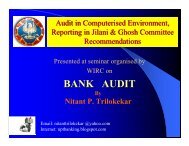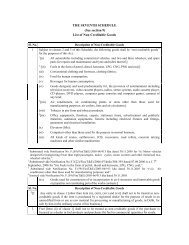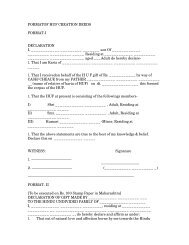communication and presentation skills a must for every ... - tnkpsc.com
communication and presentation skills a must for every ... - tnkpsc.com
communication and presentation skills a must for every ... - tnkpsc.com
Create successful ePaper yourself
Turn your PDF publications into a flip-book with our unique Google optimized e-Paper software.
COMMUNICATION AND PRESENTATION<br />
SKILLS<br />
A MUST FOR EVERY CHARTERED<br />
ACCOUNTANT<br />
CHARANJOT SINGH NANDA<br />
1<br />
FCA
INTRODUCTION<br />
“ It is the recipient who <strong>com</strong>municates. The<br />
so called Communicator, the person who<br />
emits the <strong><strong>com</strong>munication</strong>, does not<br />
<strong>com</strong>municate, he utters. Unless there is<br />
someone who hears, there is no<br />
<strong><strong>com</strong>munication</strong>. There is only noise. “<br />
(1974)<br />
Drucker<br />
2
What is Effective Communication <br />
• Communication – expression of ideas <strong>and</strong> perceptions<br />
• Communication – life-blood of the organization<br />
• Every aspect of Management revolves around<br />
Communication<br />
• Expression of knowledge through <strong><strong>com</strong>munication</strong><br />
• Carrying message across mediums<br />
• Effective Communication facilitates results<br />
• How to Communicate with precision <strong>skills</strong><br />
3
ELEMENTS OF<br />
COMMUNICATION<br />
a) THE SOURCE<br />
b) THE MESSAGE<br />
c) THE CHANNEL<br />
d) THE RECEVIERS<br />
e) THE EFFECTS<br />
f) THE FEEDBACK
ORAL COMMUNICATION<br />
According to research, an average manager in<br />
general spends only 9% of his /her time in<br />
writing, 16% in reading, 30% in speaking <strong>and</strong><br />
45% in listening as shown in the figure..<br />
45<br />
9<br />
30<br />
16<br />
Writing<br />
Reading<br />
Speaking<br />
Listening<br />
5
7 C’s of Business Communication<br />
(i) Completeness<br />
(ii)Conciseness<br />
(iii)Consideration<br />
(iv)Concreteness<br />
(v)Clarity<br />
(vi)Courtesy<br />
(vii)Correctness<br />
6
Communication For Leadership<br />
An entrepreneur DREAMS……<br />
Dream converted into VISION….<br />
Vision - <strong>com</strong>municated to achieve<br />
the MISSION<br />
Prescription <strong>for</strong> Success<br />
• Define the business of the business<br />
• create a winning strategy<br />
• <strong>com</strong>municate persuasively<br />
• Two Way Communication should be<br />
TOTAL<br />
7
Communication For Leadership<br />
Present Context :<br />
• Era of Communication<br />
• Net worked Borderless World<br />
• Today’s Executive spend 90% of time in <strong><strong>com</strong>munication</strong><br />
• Knowledge millennium<br />
* Human capital –An intangible asset<br />
* Knowledge worker / industrial worker / super<br />
empowered individual<br />
* Organization works as Symphony Orchestra<br />
* Collective genius of the Team<br />
8
Crisis Communication<br />
• Firmness <strong>and</strong> fearlessness<br />
• Reposed confidence <strong>and</strong> faith<br />
• Establish credibility<br />
• Showed concern <strong>and</strong> <strong>com</strong>passion<br />
• Admit what you don’t know<br />
• Accept responsibility<br />
• Speak in specifics<br />
• Develop positive attitude<br />
9
Effective Telephone Usage <strong>and</strong><br />
Etiquettes<br />
10
SOME DO’S<br />
•Use a silent, pulsing pager during concerts,<br />
plays or movies instead of a beeping pager or<br />
chirping cellular phone.<br />
•Return calls promptly<br />
•Send E-mail rather than call if the message is<br />
not time sensitive<br />
•Identify yourself in all <strong>for</strong>ms of<br />
tele<strong><strong>com</strong>munication</strong><br />
•Get to the point quickly<br />
•Know what you’re going to say be<strong>for</strong>e the beep<br />
11
AND DON’TS<br />
‣Eat while talking on the phone<br />
‣Send faxes of more than 10 pages without<br />
asking permission<br />
‣Call people listed on your caller ID who<br />
did not leave you a message<br />
‣Interrupt a face interaction to talk on a<br />
cellular phone<br />
‣Have an assistant place calls<br />
12
The Interview<br />
The person who gets the job may not<br />
necessarily be the most qualified; he<br />
or she may simply be the one who<br />
knows HOW to get a job<br />
13
Guidelines For the Interviewee<br />
Prepare <strong>for</strong> the interview<br />
Make an appropriate appearance<br />
Show Interest<br />
Answer correctly <strong>and</strong> Completely<br />
Practice courtesy<br />
14
What The Interviewer Seeks<br />
•Ability to Communicate<br />
•Self Confidence<br />
•Willingness to accept responsibility<br />
•Flexibility<br />
•Ability to h<strong>and</strong>le Conflict<br />
•Competitiveness<br />
•Goal Achievement<br />
•Level of Initiative<br />
•Possession of Technical <strong>skills</strong> or Ability to achieve them<br />
15<br />
Cont.
Cont.<br />
•Direction<br />
•Level of Energy<br />
•Interpersonal Skills<br />
•Leadership<br />
•Knowledge of Company<br />
16
Interview Preparation<br />
Know Yourself<br />
Know the Occupation<br />
Know the Organization<br />
Prepare Questions<br />
17
The Art of Public Speaking<br />
Strategies to Fight Stage Fright<br />
Symptoms of stage Fright<br />
‣Dry Mouth<br />
‣Tight Throat<br />
‣Sweaty H<strong>and</strong>s<br />
‣Cold H<strong>and</strong>s<br />
‣Shaky H<strong>and</strong>s<br />
‣Give me a H<strong>and</strong><br />
‣Nausea<br />
‣Fast Pulse<br />
‣Shaky Knees<br />
‣Trembling Lips<br />
18
Visualisation Strategies<br />
•Concentrate on how good you are public speaking<br />
•Pretend you are just chatting with a group of<br />
friends<br />
•Close your eyes <strong>and</strong> imagine the audience,<br />
laughing <strong>and</strong> applauding<br />
•Remember happy moments from your past<br />
•Think about your love <strong>for</strong> <strong>and</strong> desire to help the<br />
audience<br />
19
Strategies in Advance of Program<br />
‣Be extremely well prepared<br />
‣Get individual or group public speaking<br />
coaching<br />
‣Listen to music<br />
‣Read a poem<br />
‣Anticipate hard <strong>and</strong> easy question<br />
‣Organise your speaking notes<br />
‣Absolutely memorize your opening statement<br />
‣Practice,practice,practice<br />
‣Get in shape<br />
20
Strategies just be<strong>for</strong>e the program<br />
•If possible triple check the public address system<br />
•Notice <strong>and</strong> think about things around you<br />
•Get into conversation people near you<br />
•Shake h<strong>and</strong>s <strong>and</strong> smile with attendees be<strong>for</strong>e the program<br />
•Yawn to relax your throat<br />
•Look at your notes<br />
•Concentrate on your speaking ideas<br />
•Concentrate on your audience<br />
•Use eye contact<br />
21
Strategy when programme begins<br />
•If legs are trembling, lean on lectern<br />
•Try not to hold microphone by h<strong>and</strong><br />
•Don’t hold notes<br />
•Use eye contact<br />
•Look at the friendliest faces in the audience<br />
•Joke about your nervousness<br />
22
Art of Negotiation<br />
Seven Steps of Negotiations<br />
Preparing<br />
Arguing<br />
Signaling<br />
Proposing<br />
Packaging<br />
Bargaining<br />
Closing <strong>and</strong> Agreeing<br />
23
REPRESENTING BEFORE GOVERNMENT<br />
AND OTHER AGENCIES<br />
24
Re<strong>presentation</strong>s, by definition, are “<strong>for</strong>mal<br />
statements that are made to a government or<br />
other official body, in which you explain your<br />
opinion on a particular matter, usually in order<br />
to make a <strong>com</strong>plaint or request a change”.<br />
Inherent in this definition are the following<br />
elements:<br />
a) A <strong>for</strong>mal statement;<br />
. Government or other official body to which the statement<br />
is made;<br />
c) Explanation of an opinion, <strong>and</strong><br />
d) A <strong>com</strong>plaint or request <strong>for</strong> change<br />
25
SALIENT FEATURES OF A REPRESENTATION<br />
a) It <strong>must</strong> be made sure that there is a genuine <strong>com</strong>plaint. If need<br />
be, it <strong>must</strong> be substantiated with documentary proof, facts <strong>and</strong><br />
figures etc.<br />
b) In the absence of documentary proof or figures to be presented,<br />
the re<strong>presentation</strong> <strong>must</strong> be clearly written in a lucid style.<br />
c) The approach <strong>must</strong> be persuasive, so that the authorities<br />
addressed are moved to act or do something positive about the<br />
<strong>com</strong>plaint.<br />
d) A re<strong>presentation</strong> is a <strong>for</strong>mal piece of <strong><strong>com</strong>munication</strong>. It should,<br />
there<strong>for</strong>e, be serious <strong>and</strong> business like, not light hearted or<br />
conversational.<br />
e) The fact stated <strong>must</strong> be logically arranged so that the reader<br />
gives them full attention <strong>and</strong> easily <strong>com</strong>prehends the whole.<br />
Cont…..
Cont…<br />
f) It should also be kept in mind that the other party has its own<br />
limitations as well as its powers <strong>and</strong> privileges defined by<br />
rules, regulations, laws, budgetary provisions <strong>and</strong> constraints.<br />
So the dem<strong>and</strong>s <strong>must</strong> be realistic.<br />
g) At the end, what exactly is expected of the addressee <strong>must</strong> be<br />
stated in unambiguous language.<br />
h) The writer may also request <strong>for</strong> personal interview with the<br />
concerned authority. This will strengthen the case.<br />
27
VARIOUS SKILLS<br />
<strong>for</strong> Effective Communication<br />
* THINKING SKILLS<br />
*ACTION SKILLS
THINKING SKILLS<br />
•DECISION MAKING<br />
•PROBLEM SOLVING<br />
•ANALYSIS
ACTION SKILLS<br />
•COMMUNICATION SKILLS<br />
•DOING WORK
BEHAVIOUR WHEN<br />
UNDERCONFIDENT<br />
PASSIVE
BEHAVIOUR WHEN<br />
OVER CONFIDENT<br />
AGGRESSIVE
EXPRESSION<br />
• PHYSICAL- LOOKS<br />
• WORDS- CHOICE<br />
• BODY LANGUAGES<br />
• VOICE: TONE, SPEED, PAUSE,<br />
WORD STRESS, MODULATION<br />
33
EXPRESSION<br />
• PHYSICAL- LOOKS<br />
• WORDS- CHOICE --------- 07%<br />
• BODY LANGUAGES------ 55%<br />
• VOICE:TONE, SPEED,<br />
PAUSE,WORD STRESS,<br />
MODULATION------ 38%<br />
34
ANOTHER GREAT TOOL OF COMMUNICATION<br />
LISTENING SKILLS<br />
What happens when we listen<br />
•Sensing<br />
•Interpreting<br />
•Evaluating<br />
•Remembering<br />
•Responding<br />
35
Poor Listening Habits<br />
Avoiding difficult listening situations<br />
Tolerating distraction<br />
Faking attention<br />
Criticising speaking style or Mannerisms<br />
Majoring in Minors<br />
Wasting the Thinking – Speaking time<br />
differential<br />
36
Skill Building to improve Listening<br />
Habits<br />
•Focusing<br />
•Tracking<br />
•Reflecting<br />
•Digging<br />
•Damping<br />
•Redirecting<br />
37
PRESENTATION SKILLS<br />
38
Key elements of a good<br />
<strong>presentation</strong> (PANIC)<br />
• Outline your<br />
• Analyse your<br />
• Identify your<br />
• Collate your<br />
• Prepare your<br />
• Purpose<br />
• Audience<br />
• Need<br />
• In<strong>for</strong>mation<br />
• Communication<br />
39
Stages <strong>for</strong> a successful<br />
<strong>presentation</strong><br />
• Set your objective<br />
• Plan the <strong>presentation</strong><br />
• Prepare the materials<br />
• Rehearse <strong>and</strong> practice<br />
• Be ready <strong>and</strong> prepared on the day<br />
40
*What is your audience's background<br />
*What is the size, gender, etc<br />
* How knowledgeable are they<br />
*What are their strengths <strong>and</strong> weaknesses<br />
*How can your idea be of benefit/threat to them<br />
*What should your appearance be<br />
41<br />
Cont.
Cont.<br />
•What is your status in relation to your audience<br />
•Is there some <strong>com</strong>mon ground<br />
•What impression do you want to create<br />
•Have all aspects of the idea been considered<br />
•What specific points need emphasizing<br />
•What are the possible objections<br />
42
Cont.<br />
•Where will you be required to make the <strong>presentation</strong><br />
•What date <strong>and</strong> what time of the day<br />
•How many people will be attending<br />
•Are there other speakers If so, what will they be<br />
speaking about<br />
•Where in the sequence of event do you fit in<br />
•Will you need AVA facilities Microphone Can you<br />
use a microphone well<br />
•Will you be expected to provide h<strong>and</strong>outs, etc.<br />
43
Know you Audience<br />
• Who will be attending the <strong>presentation</strong>, <strong>and</strong><br />
what is their level of seniority / importance<br />
• Who is the decision-maker (where<br />
relevant)<br />
• Is there any point in giving the <strong>presentation</strong><br />
if certain people are unable to attend<br />
• Will people attend your <strong>presentation</strong> by<br />
choice<br />
44
Know you Audience<br />
• Is the initial attitude likely to be pro,<br />
neutral or anti<br />
• How intelligent are they Never talk down<br />
to people<br />
• How well in<strong>for</strong>med are they Will they<br />
have any background knowledge at all <strong>and</strong>,<br />
if so, how much<br />
• Will they underst<strong>and</strong> any jargon you<br />
normally use<br />
Cont.<br />
45
Cont.<br />
Know you Audience<br />
• What sort of mood will they be in<br />
• What will they be expecting of you<br />
• How can you present your material so as<br />
to encourage a positive response (<strong>and</strong><br />
avoid a negative reaction)<br />
46
Selection of suitable method of delivery is to be<br />
followed by examining the following questions<br />
• Do I need a record of what happened<br />
• Is the volume/<strong>com</strong>plexity of in<strong>for</strong>mation so great that<br />
the receiver will be unable to take it all in at one time<br />
• Do I want the receiver to be able to respond at once to<br />
my message<br />
• Do I want the receiver to be able to think about the<br />
message <strong>and</strong> respond at a later date<br />
• How many people do I want to get the message<br />
47
Selection of suitable method of delivery is to be<br />
followed by examining the following questions<br />
• Do I want to be able to change, add to or fine-tune the<br />
message as I deliver it<br />
• Is it a <strong>for</strong>mal or in<strong>for</strong>mal message<br />
• Am I unable to contact the receiver verbally or is it<br />
very difficult to do so<br />
• Are there geographical or physical restrictions on the<br />
means I can use<br />
48
Verbal Vs Written Communication<br />
Verbal All Verbal<br />
• Advantages • Rapid Delivery<br />
• Flexible delivery<br />
• Delivered at time/place<br />
under control of sender<br />
• Allows immediate<br />
response<br />
• Disadvantages •Can be <strong>for</strong>gotten<br />
49
Verbal Vs Written Communication<br />
Verbal Face to Face<br />
• Advantages • All advantages of verbal plus:<br />
• More personal so better<br />
motivation<br />
• Allows non-verbal signals to<br />
aid getting message across.<br />
• Disadvantages • Inability of receiver to repeat<br />
sections they are unsure of<br />
• No record<br />
• If the message is <strong>com</strong>plex or<br />
lengthy it may be lost<br />
50
Verbal Vs Written Communication<br />
Written<br />
• Advantages<br />
• A record exists of the message<br />
• Allows receiver to repeat<br />
message until it is fully<br />
understood<br />
• Good <strong>for</strong> <strong>com</strong>plex or lengthy<br />
messages<br />
• Allows receiver to digest<br />
message at own pace<br />
• Disadvantages • Takes more time<br />
• Impersonal<br />
• No immediate response <strong>for</strong><br />
sender<br />
51
PREPARATION<br />
52
To be successful<br />
•Do not tackle more than two or three ideas<br />
per speech<br />
•To make sure your message goes<br />
home, use anecdotes <strong>and</strong> examples<br />
•Work <strong>for</strong> a strong opening statement<br />
•Underline the key words in your speech<br />
•Work <strong>for</strong> a strong dynamic closing<br />
53<br />
Cont.
Cont.<br />
To be successful...<br />
•Write your introduction<br />
•Find out the seating arrangement<br />
•Enquire about the equipment -<br />
projector, screen, cord, mike, room,<br />
stage, etc.<br />
•Lighting<br />
54
• Verbal Content<br />
• Vocal Content<br />
• Body Language<br />
7%<br />
38%<br />
55%<br />
55
Body Language<br />
• Do you talk to the audience, or to the screen<br />
behind you<br />
• Do you actively seek eye contact with specific<br />
members of the audience Do you sweep over<br />
them or fix them beadily in the eye<br />
• Do you know who the decision makers are, <strong>and</strong><br />
speak primarily to them<br />
• Do you tend to concentrate on looking to the right<br />
or left, to the front or back of the audience<br />
56<br />
Cont.
Cont.<br />
Body Language<br />
• Are your gestures congruent with your message<br />
Too exaggerated Are you too stiff<br />
• Do you have any distracting mannerisms<br />
• Do you point at the audience Wag your finger<br />
• Are your movements simple Or do you pace like<br />
a caged tiger<br />
57
We Recall<br />
• 20% of what we hear;<br />
• 30% of what we see;<br />
• 50 % of what we hear <strong>and</strong> see;<br />
• 70% of what we do<br />
58
A <strong>presentation</strong> <strong>must</strong><br />
• Tell them what they need to know<br />
• Show them as much as is necessary to<br />
clarify, support <strong>and</strong> enhance your verbal<br />
message<br />
• Create opportunities <strong>for</strong> interaction - <strong>and</strong><br />
that means more than just allowing time <strong>for</strong><br />
questions<br />
59
WISH YOU ALL THE<br />
BEST


